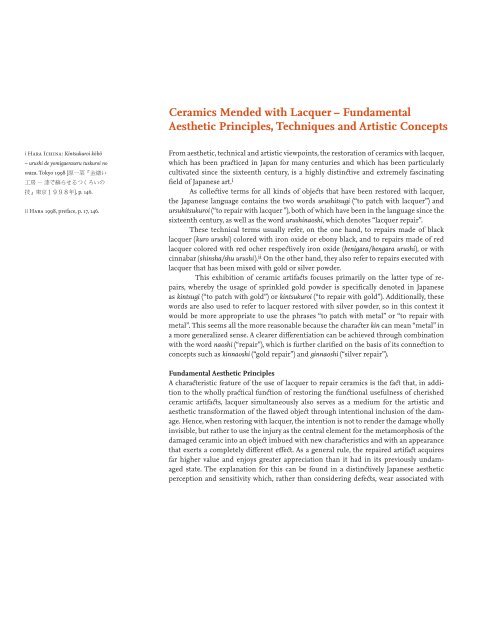Flickwerk: The Aesthetics of Mended Japanese Ceramics
Flickwerk: The Aesthetics of Mended Japanese Ceramics
Flickwerk: The Aesthetics of Mended Japanese Ceramics
Create successful ePaper yourself
Turn your PDF publications into a flip-book with our unique Google optimized e-Paper software.
i Hara Ichina: Kintsukuroi kōbō<br />
– urushi de yomigaeraseru tuskuroi no<br />
waza. Tokyo 1998 [�������<br />
����������������<br />
���������], p. 146.<br />
ii Hara 1998, preface, p. 17, 146.<br />
<strong>Ceramics</strong> <strong>Mended</strong> with Lacquer – Fundamental<br />
Aesthetic Principles, Techniques and Artistic Concepts<br />
From aesthetic, technical and artistic viewpoints, the restoration <strong>of</strong> ceramics with lacquer,<br />
which has been pract iced in Japan for many centuries and which has been particularly<br />
cultivated since the sixteenth century, is a highly distinct ive and extremely fascinating<br />
fi eld <strong>of</strong> <strong>Japanese</strong> art. i<br />
As collect ive terms for all kinds <strong>of</strong> object s that have been restored with lacquer,<br />
the <strong>Japanese</strong> language contains the two words urushitsugi (“to patch with lacquer”) and<br />
ursuhitsukuroi (“to repair with lacquer ”), both <strong>of</strong> which have been in the language since the<br />
sixteenth century, as well as the word urushinaoshi, which denotes “lacquer repair”.<br />
<strong>The</strong>se technical terms usually refer, on the one hand, to repairs made <strong>of</strong> black<br />
lacquer (kuro urushi) colored with iron oxide or ebony black, and to repairs made <strong>of</strong> red<br />
lacquer colored with red ocher respect ively iron oxide (benigara/bengara urushi), or with<br />
cinnabar (shinsha/shu urushi). ii On the other hand, they also refer to repairs executed with<br />
lacquer that has been mixed with gold or silver powder.<br />
This exhibition <strong>of</strong> ceramic artifact s focuses primarily on the latter type <strong>of</strong> repairs,<br />
whereby the usage <strong>of</strong> sprinkled gold powder is specifi cally denoted in <strong>Japanese</strong><br />
as kintsugi (“to patch with gold”) or kintsukuroi (“to repair with gold”). Additionally, these<br />
words are also used to refer to lacquer restored with silver powder, so in this context it<br />
would be more appropriate to use the phrases “to patch with metal” or “to repair with<br />
metal”. This seems all the more reasonable because the charact er kin can mean “metal” in<br />
a more generalized sense. A clearer diff erentiation can be achieved through combination<br />
with the word naoshi (“repair”), which is further clarifi ed on the basis <strong>of</strong> its connect ion to<br />
concepts such as kinnaoshi (“gold repair”) and ginnaoshi (“silver repair”).<br />
Fundamental Aesthetic Principles<br />
A charact eristic feature <strong>of</strong> the use <strong>of</strong> lacquer to repair ceramics is the fact that, in addition<br />
to the wholly pract ical funct ion <strong>of</strong> restoring the funct ional usefulness <strong>of</strong> cherished<br />
ceramic artifact s, lacquer simultaneously also serves as a medium for the artistic and<br />
aesthetic transformation <strong>of</strong> the fl awed object through intentional inclusion <strong>of</strong> the damage.<br />
Hence, when restoring with lacquer, the intention is not to render the damage wholly<br />
invisible, but rather to use the injury as the central element for the metamorphosis <strong>of</strong> the<br />
damaged ceramic into an object imbued with new charact eristics and with an appearance<br />
that exerts a completely diff erent eff ect . As a general rule, the repaired artifact acquires<br />
far higher value and enjoys greater appreciation than it had in its previously undamaged<br />
state. <strong>The</strong> explanation for this can be found in a distinct ively <strong>Japanese</strong> aesthetic<br />
perception and sensitivity which, rather than considering defect s, wear associated with


